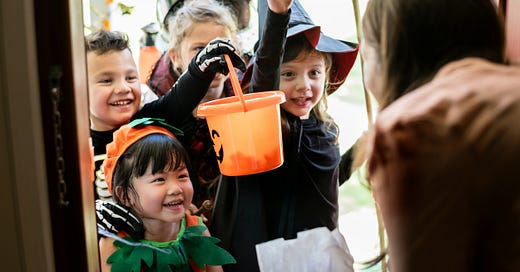Why would we want kids to be "neutral" about Halloween candy?
A case for having fun with food
Treats feel extra tricky this year.
Halloween candy fear-mongering has been building for decades. First we had the urban legends about poisoned or contaminated candy. Then when sugar became the nutritional bogeyman, candy itself became threatening. And today we’ve added a new layer of worries about food dyes and ultra-processing—though maybe it’s okay if you can steer kids toward the “high-protein candies” (yes, that phrase has been trending lately).
But there’s also more awareness than ever about the importance of fostering a healthy relationship with food. And so families who want to feed their kids “the right way” can feel like they’re in a double bind.
If you put strict limits on candy, you worry about setting the stage for a disordered relationship with food or even an eating disorder. If you let kids have a free-for-all, you worry about whether any of the growing list of other scary possibilities could be the next knock at the door.
In a world where every day another TikToker shouts about the ingredients in kids’ food, it’s worth remembering a line often repeated by eating disorder professionals:
There is nothing in a food that could harm a child more than a fear of food.1
One of the common strategies for avoiding both fear and fixation is to take sweets off a pedestal (or off a “poison” list) and instead give kids regular access. Rather than make a big deal about candy, families can dampen some of the glittery gravitational glow by treating candy and other sweets with a more matter-of-fact tone and approach.
Adopting a neutral, all-foods-fit approach means the candy bowl in some homes will start collecting dust before long.
When a sense of scarcity is replaced by predictable availability, many kids (and adults), find themselves feeling less urgently pulled toward those coveted foods. That almost addictive-like response can fade once the food in question is no longer viewed as something illicit, a temptation you’re always trying to resist. And this makes sense because “the forbidden fruit tastes the sweetest” (a line I seem to repeat in almost every newsletter).
But it doesn’t mean everyone will necessarily stop wanting or enjoying that fruit once they have full permission to eat it.
Thanks to diet culture, however, many parents assume that being able to pass up sweets is the ultimate goal of food neutrality, that if you habituate your child to a desired food, they will simply want less of it.
Saying no to dessert and leaving the donut half-eaten are often touted as evidence of success. That the only sure sign of “listening to their body” is to leave food on the plate, to refuse sweets, and maybe even to start craving protein, vegetables, and whole grains.
It’s as if we’re saying sweets are okay but only if the ultimate goal is for your kid not to be that interested in them?
You can’t have your cake, but you didn’t really want it anyway.
And that’s where some seemingly anti-diet advice can set families up for confusion. Children’s bodies are also giving them important signals about hunger and preferences. So if we are seeing restriction as the secret goal of food neutrality, we’ve lost the plot, just like influencers selling “intuitive eating for weight loss.”
What does “food neutrality” even mean?
The foundation of food neutrality is that foods and food choices are morally neutral. You aren’t a better human being for eating a certain way.
The concept of food neutrality exists because diet culture turned food choices into a good vs. evil competition. What is deemed virtuous tends to be lower sugar, lower calories, higher protein, higher expense and/or more work (e.g., making everything from scratch).
Grocery stores play into these worries with “Reduced Guilt” product lines (I’m looking at you, my beloved Trader Joe’s). Menus describe chocolate desserts as “sinful.” Diet plans often recommend “being good” except for an occasional “cheat meal.”
We’ve been taught that if something is delicious, pleasurable, and easy to eat, then it must be bad—and if we “indulge” in it, we are bad, too. Unless, that is, we atone for our sins and punish ourselves with exercise, restriction, and a side of mental self-flagellation.

For parents who don’t want their kids to get stuck in that disordered mindset, food neutrality and an all-foods-fit approach can be really helpful.
Normalizing rather than restricting sugary foods is the common recommendation when kids are sneaking and bingeing candy, feeling guilty for eating sweets, or spending a slumber party raiding another family’s treat drawer.
But I don’t think the anti-diet messages always do a great job of presenting the larger benefits of food neutrality. And so some parents assume they’re doing it wrong if their child still wants seconds on dessert and passes up veggies. Or they mistake a child’s enjoyment for obsession and conclude the “method didn’t work” or that it cannot work in today’s food environment.
Most kids will continue to want and enjoy sweets.
And I say, thank goodness.
At Halloween, even those who might usually have a take-it-or-leave-it approach to goodies are likely to be exhilarated by the trick-or-treat of it all.
And it doesn’t mean they’re just being manipulated by food scientists’ concoctions or colorful, crinkly packaging designed to override human reason or internal body cues.
It’s Halloween, people.
It’s supposed to be thrilling and unusual and a little transgressive. And candy plays a big role in the whole experience.
The goal of food neutrality is not to diminish pleasure so kids can more closely follow the puritanical rules of diet culture.
It’s so that they can eat without shame, guilt, fear, or fixation. Experiencing more calm and peace around food doesn’t mean there isn’t also room for enjoyment.
Being unable to feel excitement or pleasure around food can have serious mental and physical health consequences. Why would that be a goal in feeding our kids?
I wouldn’t want my kids to feel neutral about Halloween candy—or any other celebratory food, like birthday cake or holiday treats.2 These are moments for memories, ritual, and delight.
Feeding ourselves or our kids solely based on optimizing quantifiable nutrition details sounds pretty grim and stressful. It also sounds a lot like orthorexia.
Food is so much more than a nutrient delivery system. More than a list of ingredients. More than macros.
Enjoying food doesn’t just help us survive. It enriches our lives in so many intangible ways. It’s one of the joys of life, connecting us to other people, our community, our traditions, our culture, our humanity.
Just in case there’s any confusion, I’m not saying kids should eat only sugar, all day long, forever.
And, of course, parents are free to set the food boundaries that make sense for their family.
But when parents provide structure and support around food, honoring a child’s appetite and preferences is an important piece to remember.
Food isn’t always going to feel fun. It serves a functional purpose, too. And I don’t deny that what we eat can play a role in our health. But I also know that how we eat and relate to food affects our family’s health, too.
Embracing food pleasure—rather than trying to vanquish it—may even be the best thing for our kids’ wellbeing.
In case you missed it
Last year I contributed to this CNN piece about Halloween candy:
Exceptions, obviously, for kids with allergies or certain other medical conditions.
I have observed that many families navigating significant medical issues requiring food label vigilance are eager to appreciate pleasure around eating—and are often flummoxed by diet culture’s arbitrary restrictions. See Debi Lewis’s poignant memoir, Kitchen Medicine, for some great examples.






Yay for treats! This is such a helpful read for anyone stressing about Halloween candy!
As I wrote in my post today, I’d love to see non-sweet treats beyond chips (not even sure if they do them anymore. My son didn’t get any last year or the year before, I don’t think). He’s got more of a sweet tooth than I do but it WOULD be nice! I remember getting popcorn from a lady dressed as a witch but my mom wouldn’t let me keep it because it was self-bagged (80s, during the time of all the fear-mongering of contaminated treats.